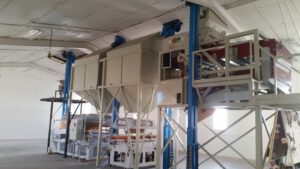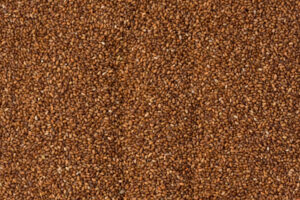One way for farmers to improve soil and reduce the risk of crop loss is to diversify crop rotations. More than a decade ago, a couple of farmers in northern Nevada’s Truckee-Carson Irrigation District—with the help and guidance of their local agricultural extension agent—started growing a staple of the highlands of the Horn of Africa, teff, to provide such diversity. Teff is the world’s smallest grain, but it produces a variety of items, including flour used for injera, a spongy Ethiopian flatbread, and high-quality hay for livestock and horses. Teff is high in protein and fiber and is gluten free. The crop is well suited to Nevada’s high elevations and arid climate, and its introduction has been nothing short of successful. According to the University of Nevada Cooperative Extension, in 2016 Nevada farmers produced 2.6 million pounds of teff, valued at $1.2 million, across 2,000 acres.
Nevada agriculture has traditionally focused on the growth and production of alfalfa hay for feed. Nevada farmers dedicate more than 90 percent of the state’s irrigated acres to alfalfa production. The reliance on alfalfa puts producers at risk in times of drought or low commodity prices.
For John Getto, owner of Desert Oasis Teff, growing teff came from his efforts to find a good rotation crop to work in with his alfalfa. Jay Davison, a forage and alternative crops specialist at the University of Nevada Cooperative Extension, had been working on introducing northern Nevada farmers and ranchers to the crop. He connected Mr. Getto to a grower from Idaho interested in running test plots of teff. “We [Mr. Getto and his business partner] watched the test plots and thought teff would be a good rotation crop. We started 20–30 acres and worked our way up from there.”
Teff requires less water than alfalfa, which is a critical value for Nevada growers. The grass has a shallow root system, so it does well in rotation after alfalfa. Where wheat may take up to 10 irrigations in northern Nevada, teff requires half that.
The area’s growing season is very short. Mr. Getto plants his teff seeds on or near the first of June and harvests in September. “Water here is a very big issue— we are limited in the water we get. All of it comes out of the Sierra Nevada. However, if you are short of water and you only have five or six irrigations, you can make your teff crop work.”
 While Mr. Getto has been farming in Fallon, Nevada, for more than 20 years, his new crop required new gear. “We had to buy special swathers for harvest. Teff is a tall grass that lays flat. You have to swath it in a windrow, let it dry for a few days, bring in a combine to pick it up and thrash it, and then haul it to a facility and bag it. We store it all here.”
While Mr. Getto has been farming in Fallon, Nevada, for more than 20 years, his new crop required new gear. “We had to buy special swathers for harvest. Teff is a tall grass that lays flat. You have to swath it in a windrow, let it dry for a few days, bring in a combine to pick it up and thrash it, and then haul it to a facility and bag it. We store it all here.”
In fact, Desert Oasis Teff built a whole new facility for cleaning teff. “We keep track of each grower’s seeds; the growers gets paid on a clean grain. We clean it on size and then by weight. Then the clean product goes back into a big polywhite bag.”
Desert Oasis Teff ’s customer base is growing. Mr. Getto first began selling to an Ethiopian restaurant in Reno. From there, the company staring selling to natural foods company Bob’s Red Mill, based in Portland, Oregon. “Now, we are starting to get some other outside people interested. We are going to try and market this ourselves—bag it and brand it. It is a good product, and we would like to get it moving.”



